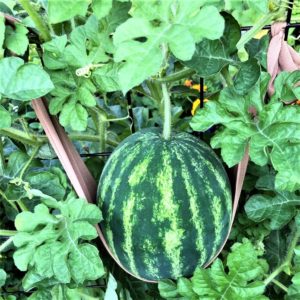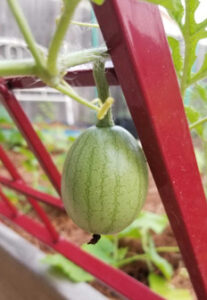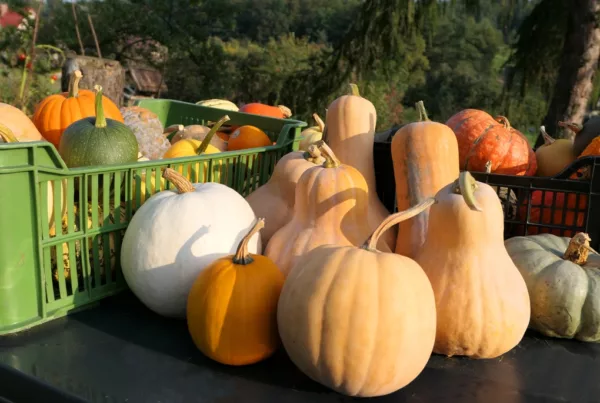Written by Chris McLaughlin

Plant small melon varieties to grow vertically.
If you love watermelons, muskmelons, cantaloupe, or honeydew, the trellis attached to your Square Foot Garden is the perfect place to grow some of the sweetest fruit of summer.
Mel Bartholomew always said that growing ‘up’ really moved Square Foot Gardening into another realm. SFG was the first technique that demonstrated many ground-vine plants loved to grow vertically.
Count melons in that camp: a trellis gives them more air circulation and sun, and getting the plants off the ground makes them less susceptible to pests, fungi and diseases.
Inspired? Here’s what you’ll need to grow these delicious, sweet treats in your SFG.
Melons Need Support

Get clever with melon slings.
First, you’ll need a trellis that is strong with good frame support. For smaller melons, netting or wooden A-frames can work, but I prefer cattle panels or thick-gauged field fencing for heavier varieties. Second, the easiest melons to grow vertically are varieties that produce fruits that are two to seven pounds in size.
The bigger the melon (like a seven pounder), the more support it will need on your trellis. I recommend a sling of some type that is tied to the trellis, creating a hammock for the growing fruit. Try onion or potato bag netting, fabric, pantyhose, leftover facemasks, etc.
Check out these trellis ideas:
Trellis Tricks: Grow “Up” for Bigger SFG Harvests
SFG Essentials – Vertical Gardening with Rick Bickling
Melon Growing Tips
Melons can be started indoors as early as three weeks before the last frost in your area. However, they perform extremely well when started from seed directly into your SFG. Depending on the size of the fruit, plant them 1 per square or even 1 per 2 squares. They want a sunny position in the garden, should be located on the north side of your bed (so they don’t block the sun for other squares with shorter plants), and thrive in our Mel’s Mix which provides fertile, well-draining soil.
Melon seeds, seedlings, and young plants need regular watering. In very hot weather, they appreciate a layer of mulch such as chopped straw. Once they have set fruit, you can back off the water a bit. A square that’s continually saturated with water tends to dilute the sugar in the melons. When the fruits are a week or so away from harvesting, water them just enough to keep the leaves from wilting.
Being heavy feeders, your melons will appreciate some extra compost during the growing season.
Try These Tasty Varieties

This softball-sized cantaloupe is ‘Minnesota Midget’
‘Sleeping Beauty’ – Muskmelon/ 1/2 lb. fruit/ 85 days.
‘Tigger’ – Muskmelon/ 1 lb. fruit/ 85 days.
‘Minnesota Midget’ – Cantaloupe / 1 lb. fruit / 60-70 days.
‘Golden Midget’ – Watermelon/ 3 lb. fruit/ 70 days.
‘Ambrosia’ – Muskmelon/4-5 lb. fruit/ 83-86 days.
‘Orange Honeydew’ – Honeydew x muskmelon/5-6 lbs./ 105 days.
‘Yellow Doll’ – Watermelon/5-8 lb. fruit/ 68-70 days.
‘Sugar Baby’ – Watermelon/8-10 lbs./ 80 days.
‘Blacktail Mountain’ – Watermelon/8-12 lbs./ 70 days.
Ripe and Ready to Harvest
Unlike some other SFG produce that continues to ripen after picking, when you pick a melon, it stops that process right away. So you have to wait until the ideal moment to harvest. How can you tell when a melon is ripe? Here are the signs:

Sugar baby watermelon.
Watermelons
- The little tendril next to the stem is brown and shriveled.
- The outside of the watermelon (rind) has turned dull looking instead of shiny.
- You hear a dull thud sound when you flick the outside with your finger.
- It should pull from the vine with just a gentle tug.
Cantaloupe
- The stem becomes brown; often there’s a little crack where the stem meets the vine.
- The rind under that “netting” texture on the surface changes from green to yellowish-cream. The netting will be raised and tan.
- It will slip easily from the vine.
- They will have a sweet, musky, fruity aroma.
Honeydew
- The bottom of the honeydew (opposite the stem) should have some ‘give’ to it. It’ll feel soft or springy.
- It will have a smooth and waxy rind.
- The rind will become a creamy yellow when ready to harvest.
- Unlike other melons, ripe honeydews will not ‘slip’ easily from the vine. You’ll have to carefully snip the stem from the vine with pruning shears.
Thanks SFG gardeners Kristen, Natalie and Courtney for your wonderful melon photos!



